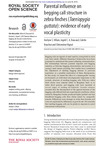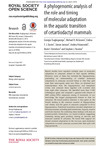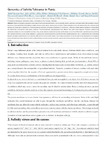Browsing Học liệu mở OER by Title
Now showing items 646-665 of 933
-
Parental influence on begging call structure in zebra finches
(2015)Begging calls are signals of need used by young birds to elicit care from adults. Different theoretical frameworks have been proposed to understand this parent–offspring communication. But relationships between parental ... -
Parental investment in child health in sub-Saharan Africa: a cross-national study of health-seeking behaviour
(2016)Parents face trade-offs between investing in child health and other fitness enhancing activities. In humans, parental investment theory has mostly been examined through the analysis of differential child outcomes, with ... -
Parents face quantity quality trade offs between reproduction and investment in offspring in Iceland
(2016)How to optimally allocate time, energy and investment in an effort to maximize one’s reproductive success is a fundamental problem faced by all organisms. This effort is complicated when the production of each additional ... -
Peculiar macrophagous adaptations in a new Cretaceous pliosaurid
(2015)During the Middle and Late Jurassic, pliosaurid plesiosaurs evolved gigantic body size and a series of craniodental adaptations that have been linked to the occupation of an apex predator niche. Cretaceous pliosaurids (i.e. ... -
The Peer Reviewers’ Openness Initiative
(2016)Openness is one of the central values of science. Open scientific practices such as sharing data, materials and analysis scripts alongside published articles have many benefits, including easier replication and extension ... -
The perilous state of seagrass in the British Isles
(2016)Seagrass ecosystems face widespread threat from reduced water quality, coastal development and poor land use. In recent decades, their distribution has declined rapidly, and in the British Isles, this loss is thought to ... -
Personal Finance
(The Saylor Foundation, 2009)Personal Finance by Rachel Siegel and Carol Yacht is a comprehensive Personal Finance text which includes a wide range of pedagogical aids to keep students engaged and instructors on track. This book is arranged by learning ... -
Phenotype limited distributions
(2015)In our seasonal world, animals face a variety of environmental conditions in the course of the year. To cope with such seasonality, animals may be phenotypically flexible, but some phenotypic traits are fixed. If fixed ... -
Phenotypic assortment in wild primate networks
(2015)Individuals’ access to social information can depend on their social network. Homophily—a preference to associate with similar phenotypes—may cause assortment within social networks that could preclude information transfer ... -
A pheromone outweighs temperature in influencing migration of sea lamprey
(2015)Organisms continuously acquire and process information from surrounding cues. While some cues complement one another in delivering more reliable information, others may provide conflicting information. How organisms extract ... -
Photothermal raster image correlation spectroscopy of gold nanoparticles in solution and on live cells
(2015)Raster image correlation spectroscopy (RICS) measures the diffusion of fluorescently labelled molecules from stacks of confocal microscopy images by analysing correlations within the image. RICS enables the observation of ... -
Phylogenetic tests reject Emery’s rule in the evolution of social parasitism in yellowjackets and hornets
(2015)Social parasites exploit the brood-care behaviour and social structure of one or more host species. Within the social Hymenoptera there are different types of social parasitism. In its extreme form, species of obligate ... -
A phylogenomic analysis of the role and timing of molecular adaptation in the aquatic transition of cetartiodactyl mammals
(2015)Recent studies have reported multiple cases of molecular adaptation in cetaceans related to their aquatic abilities. However, none of these has included the hippopotamus, precluding an understanding of whether molecular ... -
Phylotranscriptomic analysis uncovers a wealth of tissue inhibitor of metalloproteinases variants in echinoderms
(2015)Tissue inhibitors of metalloproteinases (TIMPs) help regulate the extracellular matrix (ECM) in animals, mostly by inhibiting matrix metalloproteinases (MMPs). They are important activators of mutable collagenous tissue ... -
Physical Geology
(Campus Manitoba, 2016)Physical Geology is a comprehensive introductory text on the physical aspects of geology, including rocks and minerals, plate tectonics, earthquakes, volcanoes, glaciation, groundwater, streams, coasts, mass wasting, climate ... -
Physical Modeling in MATLAB
(Green Tea Press, 2014)Chapter 1: Variables and Values. Chapter 2: Scripts. Chapter 3: Loops. Chapter 4: Vectors. Chapter 5: Functions. Chapter 6: Zero-finding. Chapter 7: Functions of vectors. Chapter 8: Ordinary Differential Equations. Chapter ... -
Physiological tremor reveals how thixotropy adapts skeletal muscle for posture and movement
(2016)People and animals can move freely, but they must also be able to stay still. How do skeletal muscles economically produce both movement and posture? Humans are well known to have motor units with relatively homogeneous ... -
Plant Genomics. Chapter 10: Advances in Plant Tolerance to Biotic Stresses
(INTECH Open Access Publisher, 2016)Plants being sessile in nature encounter numerous biotic agents, including bacteria, fungi, viruses, insects, nematodes and protists. A great number of publications indicate that biotic agents significantly reduce crop ... -
Plant Genomics. Chapter 11: Genomics of Salinity Tolerance in Plants
(INTECH Open Access Publisher, 2016)Plants are frequently exposed to wide range of harsh environmental factors, such as drought, salinity, cold, heat, and insect attack. Being sessile in nature, plants have developed different strategies to adapt and grow ... -
Plant Genomics. Chapter 1: Genomics Era for Plants and Crop Species – Advances Made and Needed Tasks Ahead
(INTECH Open Access Publisher, 2016)Historically, unintentional plant selection and subsequent crop domestication, coupled with the need and desire to get more food and feed products, have resulted in the continuous development of plant breeding and genetics ...




















